Iowa Space Grant Consortium (ISGC) Base Program for Aircraft Icing Studies
About Iowa Space Grant Consortium (ISGC):

The
Iowa Space Grant Consortium (ISGC) is part of the
National Space Grant College and Fellowship Program from NASA which is
designed to support science and engineering education. The ISGC funds
activities at Iowa State University, the University of Iowa, the University
of Northern Iowa and Drake University to coordinate and improve Iowa's
future in aerospace science and technology and to stimulate aerospace
research, education and outreach. Funded research is done in collaboration
with other researchers in government (especially NASA), industry and
nonprofit organizations. Funding from ISCG is used to purchase supplies
necessary for the research and provide scholarships for students
participating in the research.
The ISGC support may also be used for domestic travel to
conferences and/or NASA Centers for collaboration and networking.
About the ISGC Base Program for Aircraft Icing Studies:
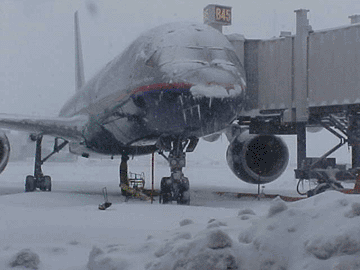 Aircraft
icing is widely recognized as a significant hazard to aircraft operations in
cold weather. When an aircraft or rotorcraft flies in a cold climate, some
of the super cooled droplets would impact and freeze on exposed aircraft
surfaces to form ice shapes. Ice may accumulate on every exposed frontal
surface of an airplane, not only on the wing, propeller and windshield, but
also on the antennas, vents, intakes, and cowlings. Icing accumulation can
degrade the aerodynamic performance of an airplane significantly by
increasing drag while decreasing lift. In moderate to severe conditions, an
airplane can become so iced up that continued flight is impossible. The
airplane may stall at much higher speeds and lower angles of attack than
normal. It can roll or pitch uncontrollably, and recovery may be impossible.
Ice can also cause engine stoppage by either icing up the carburetor or, in
the case of a fuel-injected engine, blocking the engine’s air source. The
importance of proper ice control for aircraft operation in cold climate was
highlighted by many aircraft crashes in recent years like the deadly
accident occurred at Clarence Center, New York on February 12, 2009 with 50
souls lost in the accident of a Bombardier DHC-8-400 aircraft operating as
Continental Flight 3407. Similarly, the Embraer EMB-12RT aircraft collided
with terrain at Monroe, Michigan, killing 27 people on January 9, 1997. The
ART-72 aircraft operating as American Eagle Flight 4184
collided with terrain at Roselawn, Indiana on October
31, 1994 due to freezing rain, killing 68 people. Military aircraft
are not immune from icing hazards either. Military operates airfields across
the world, many of which require de-icing/anti-icing to be conducted if
operations are to continue during cold weather. Icing has been found to
causes military mission delays during ground deicing of aircraft and even
mission cancellations and abortions because of forecast or actual in-flight
icing. Regardless of the aircraft type being supported, the methods of
de-icing /anti-icing and the concerns that accompany it remain the same.
While research progress has been made in recent years in providing better
understanding about aircraft icing phenomena, aircraft icing remains as an
important unsolved problem at the top of the National Transportation Safety
Board’s most wanted list of aviation safety improvements.
Aircraft
icing is widely recognized as a significant hazard to aircraft operations in
cold weather. When an aircraft or rotorcraft flies in a cold climate, some
of the super cooled droplets would impact and freeze on exposed aircraft
surfaces to form ice shapes. Ice may accumulate on every exposed frontal
surface of an airplane, not only on the wing, propeller and windshield, but
also on the antennas, vents, intakes, and cowlings. Icing accumulation can
degrade the aerodynamic performance of an airplane significantly by
increasing drag while decreasing lift. In moderate to severe conditions, an
airplane can become so iced up that continued flight is impossible. The
airplane may stall at much higher speeds and lower angles of attack than
normal. It can roll or pitch uncontrollably, and recovery may be impossible.
Ice can also cause engine stoppage by either icing up the carburetor or, in
the case of a fuel-injected engine, blocking the engine’s air source. The
importance of proper ice control for aircraft operation in cold climate was
highlighted by many aircraft crashes in recent years like the deadly
accident occurred at Clarence Center, New York on February 12, 2009 with 50
souls lost in the accident of a Bombardier DHC-8-400 aircraft operating as
Continental Flight 3407. Similarly, the Embraer EMB-12RT aircraft collided
with terrain at Monroe, Michigan, killing 27 people on January 9, 1997. The
ART-72 aircraft operating as American Eagle Flight 4184
collided with terrain at Roselawn, Indiana on October
31, 1994 due to freezing rain, killing 68 people. Military aircraft
are not immune from icing hazards either. Military operates airfields across
the world, many of which require de-icing/anti-icing to be conducted if
operations are to continue during cold weather. Icing has been found to
causes military mission delays during ground deicing of aircraft and even
mission cancellations and abortions because of forecast or actual in-flight
icing. Regardless of the aircraft type being supported, the methods of
de-icing /anti-icing and the concerns that accompany it remain the same.
While research progress has been made in recent years in providing better
understanding about aircraft icing phenomena, aircraft icing remains as an
important unsolved problem at the top of the National Transportation Safety
Board’s most wanted list of aviation safety improvements.
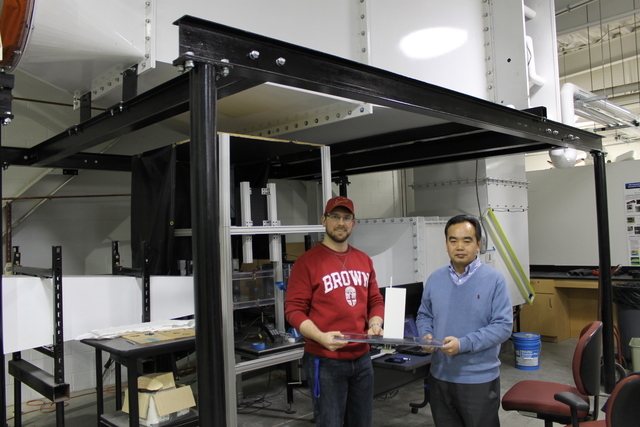 This
ISGC base program will leverage the uniqueness of the icing research wind
tunnel available (IRWT) at Iowa State University (ISU) and the technical
strengths and expertise of ISU researchers on icing physics and modeling;
experimental aerodynamics and heat transfer; computational fluid mechanics (CFD);
multiphase physics modeling and simulation; high-performance computing and
data mining; high-speed imaging and non-destructive evaluation (NDE);
surface chemistry; hydrophobic coatings and surface engineering; smart
materials and nanotechnology to synergize a research and education
integrated program to conduct theoretical, computational, and experimental
investigations on important micro-physical processes pertinent to aircraft
icing and anti-/de-icing technology. A better understanding of the important
micro-physical processes will enable us to improve current icing accretion
models for more accurate prediction of ice formation and accretion processes
on aircraft as well as to develop more effective and robust anti-/de-icing
strategies to ensure safer and more efficient operation of aircraft in cold
weather.
This
ISGC base program will leverage the uniqueness of the icing research wind
tunnel available (IRWT) at Iowa State University (ISU) and the technical
strengths and expertise of ISU researchers on icing physics and modeling;
experimental aerodynamics and heat transfer; computational fluid mechanics (CFD);
multiphase physics modeling and simulation; high-performance computing and
data mining; high-speed imaging and non-destructive evaluation (NDE);
surface chemistry; hydrophobic coatings and surface engineering; smart
materials and nanotechnology to synergize a research and education
integrated program to conduct theoretical, computational, and experimental
investigations on important micro-physical processes pertinent to aircraft
icing and anti-/de-icing technology. A better understanding of the important
micro-physical processes will enable us to improve current icing accretion
models for more accurate prediction of ice formation and accretion processes
on aircraft as well as to develop more effective and robust anti-/de-icing
strategies to ensure safer and more efficient operation of aircraft in cold
weather.
Research Teams Working on the ISGC Base Program for Aircraft Icing Studies:
Faculty members:
|
|
 Dr. Alric Rothmayer Professor Department of Aerospace Engineering Iowa State University 2271 Howe Hall - Room 2235, Ames, IA 50011 Phone: 515-294-8851 Email:roth@iastate.edu |
ISGC Fellowship Awardees:
|
Mr. Andrew Bodling PhD student Email: AndrewBodling@gmail.com |
Mr. Ira Mitchell Undergraduate Research Assistant Email: iram@iastate.edu |
Mr. Toby Cruz Undergraduate Research Assistant Email: tbcruz@iastate.edu |
Miss
Miriam Wilson Undergraduate Research Assistant Email: miriamw@iastate.edu |
|
|
|
|
|
|
Miss Ashley Johnson Undergraduate Research Assistant Email: ashleyj@iastate.edu |
|
Sample Results Derived from the ISGC Base Program for Aircraft Icing Studies:

(a). Over the upper surface of the airfoil

(b). Over the lower surface of the airfoil
Glaze ice accretion process over a NACA0012 airfoil with airflow speed V=35m/s, T=-8°C, α = 5.0 deg. (Waldman & Hu, 2014)
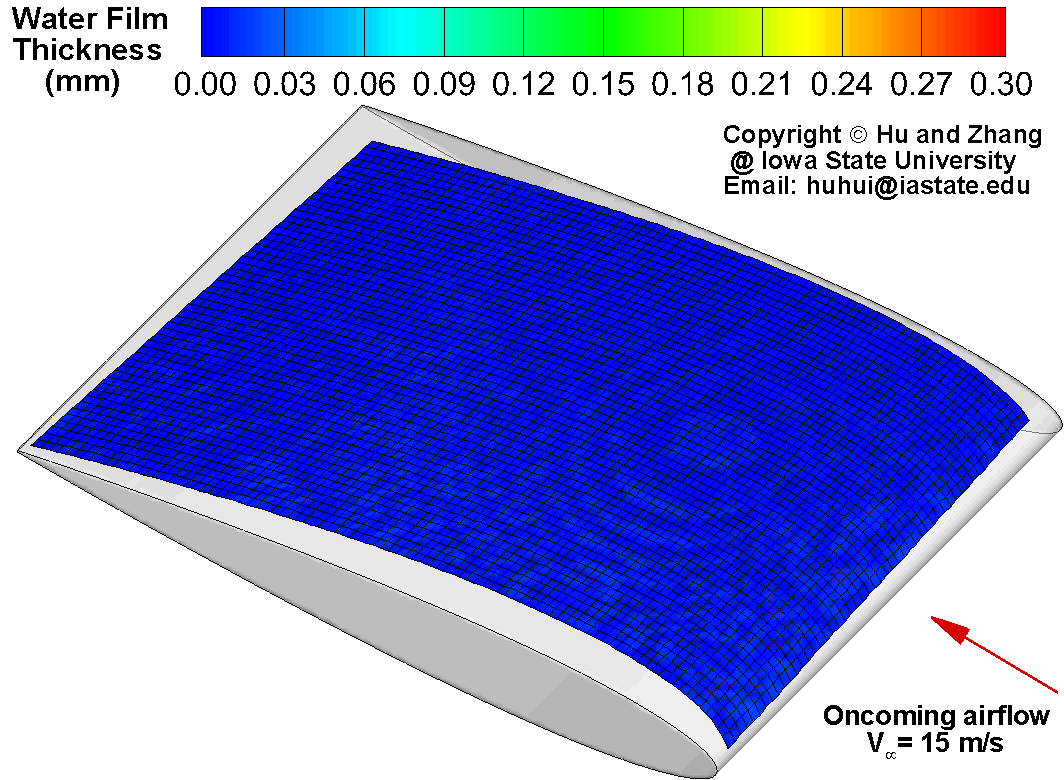
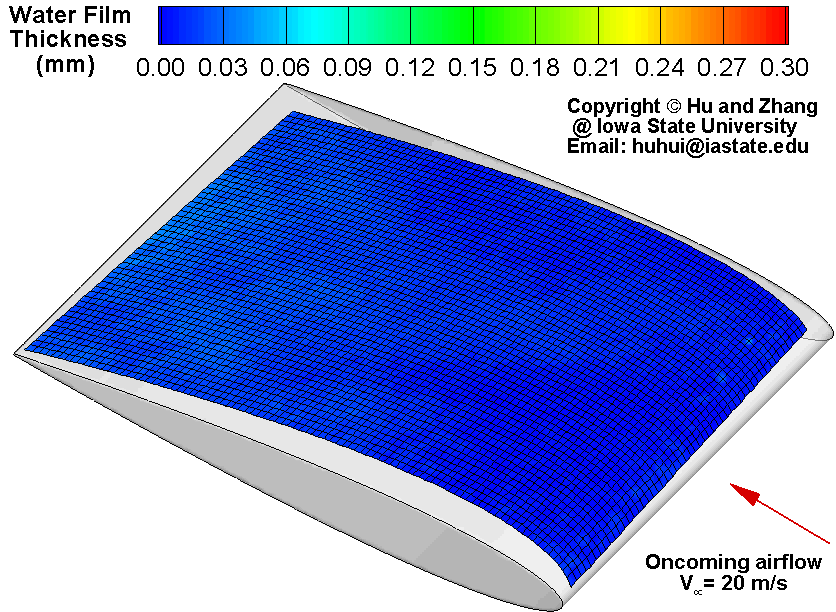
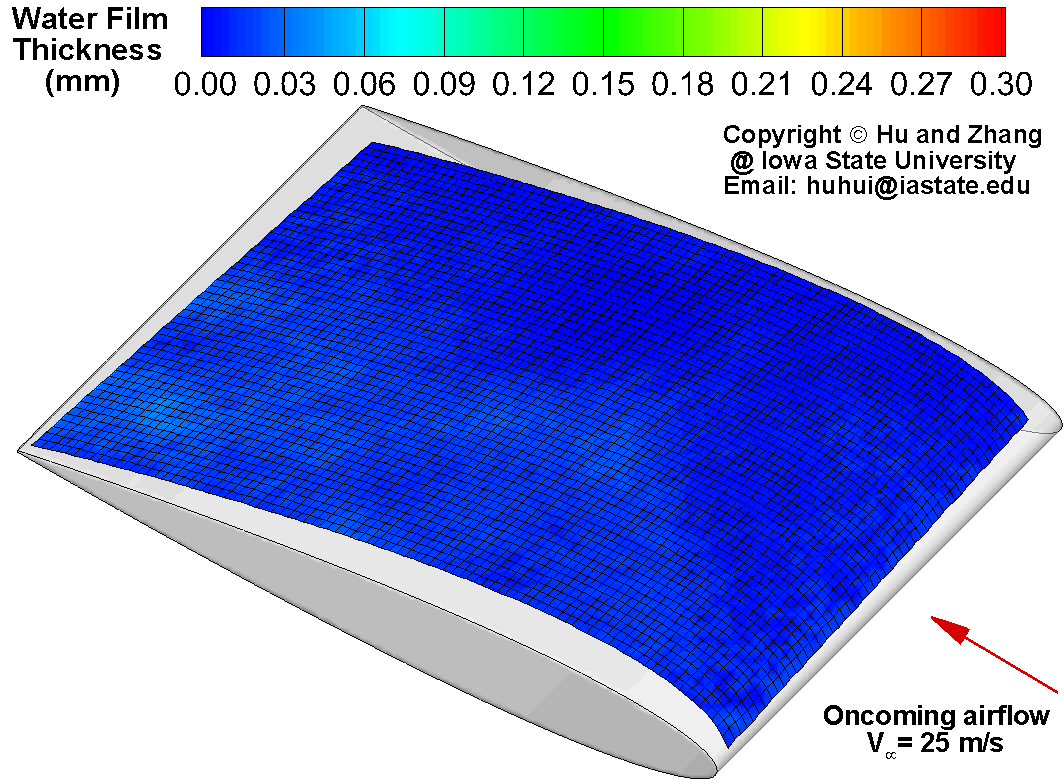
(a). airflow velocity V=15m/s (b). airflow velocity V=20m/s (c). airflow velocity V=25m/s
Surface water rivulet/film flow over a NACA0012 airfoil pertinent to aircraft icing phenomena (Zhang & Hu et al. 2013)
![]()
![]()
Department of Aerospace Engineering, Iowa State
University, 2271 Howe Hall, Room 1200, Ames, Iowa 50011
Copyright © Iowa State University. All rights reserved.







